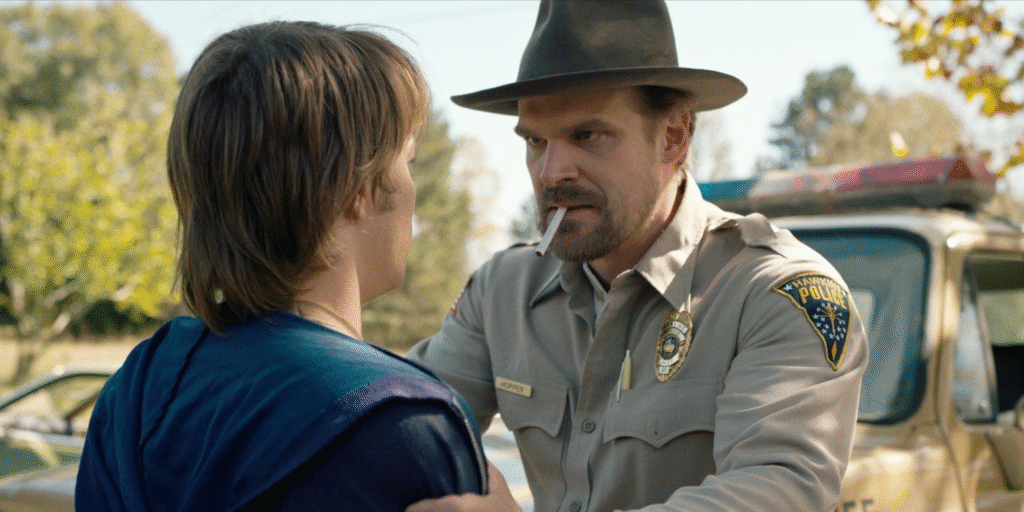What do Stranger Things, Euphoria, and The Queen’s Gambit have in common? Not only are they massively popular streaming shows, but they also feature characters smoking. In an era where every pack of cigarettes warns ‘Smoking kills’, these shows remind us cigarettes – and now vapes – still occupy a powerful place in pop culture’s visual language.

Numbers don’t lie: Smoking in the media
According to the National Opinion Research Centre at the University of Chicago, tobacco incidents in top-grossing films rose by 70% in 2023, climbing from 1,167 in 2022 to 1,989. Even movies marketed to younger audiences aren’t immune: nearly a quarter of youth-rated films (G, PG, PG-13) contained tobacco imagery. That means millions of children and teens are still seeing nicotine use presented as part of the story – and often, part of what makes a character seem cool, edgy, or complex.
Lights, camera, smoke!
However, it didn’t start with Netflix. For much of the 20th century, smoking wasn’t just common in daily life – it was a cinematic symbol of danger, introspection and control. When Hollywood’s Golden Age stars like Clark Gable or Marlene Dietrich lit up on the screen, each cigarette added an air of mystery to their characters. Behind the scenes, tobacco companies worked hard to promote their products. Actors were paid to publicly endorse cigarette brands in magazines and newsreels, while screenplays were peppered with smoking scenes that reinforced brand familiarity.
The reality check: The Surgeon General’s Warning
The glamour of cigarettes on screen began to clash with reality in the 1960s. In 1964, the Surgeon General of the United States released a landmark report linking smoking to serious health risks, including cancer and heart disease. This warning marked a turning point: smoking could no longer be portrayed purely as stylish or harmless. Filmmakers faced growing scrutiny, and public health campaigns began actively challenging the seductive image of smoking on screen.
Around the world: The WHO steps in
In 2003, the World Health Organisation adopted the Framework Convention on Tobacco Control, a global treaty that includes Article 13, which calls for restrictions on tobacco advertising, promotion, and sponsorship — including indirect forms such as product placement. Around the same time, a study published in The Lancet evaluated that smoking depicted in films might be responsible for 52% of smoking initiation among young people in the United States.
Rated R… for Responsibility: Tobacco on screen
In response, major film studios began to update their internal policies. The Motion Picture Association of America (MPAA) implemented guidelines that highlighted smoking as a factor in film ratings. Many studios committed to removing smoking from films rated for younger audiences unless there was a historical context for its inclusion. As a result, the portrayal of tobacco use in the highest-grossing films decreased, particularly in those targeted at younger viewers. By 2010, the representation of smoking in mainstream cinema had significantly dropped, and the once-celebrated habit appeared to have been pushed to the outskirts of popular narratives.
Guess who’s back? Smoking returns
Despite a drop in the number of smoking representations, recent years have seen a notable resurgence. The Queen’s Gambit, one of the highest-streaming TV series in 2020, included 220 tobacco depictions. The first 3 seasons of Stranger Things included 721 tobacco depictions. Even the Oscar-winning Oppenheimer depicted the scientist smoking, yet omitted throat cancer, the reason for his death, which is commonly associated with smoking.

The Final Scene: Smoking in Stories Today
From the glamorous cigarette-lit screens of Old Hollywood to the high-definition streaming shows of today, smoking has remained a powerful visual symbol in storytelling. While regulations and public health campaigns have reduced its prevalence, particularly in content aimed at young audiences, tobacco imagery persists — subtly or overtly shaping perceptions of rebellion, sophistication, and emotional depth.
Pop culture doesn’t just reflect society; it influences it, and as long as cigarettes and vapes appear in the stories we consume, their cultural weight endures.
Sources:
Netflix kept showing smoking in TV shows despite 2019 pledge, study finds by Zachary Snowdon Smith
Tobacco in Films 2023, presented by the National Opinion Research Centre at the University of Chicago
Back on Screen: The Return of Smoking in Films and Its Public Health Implications by Adriana Albini
Historical films and TV depict smoking, not its harmful health impacts




Leave a Reply